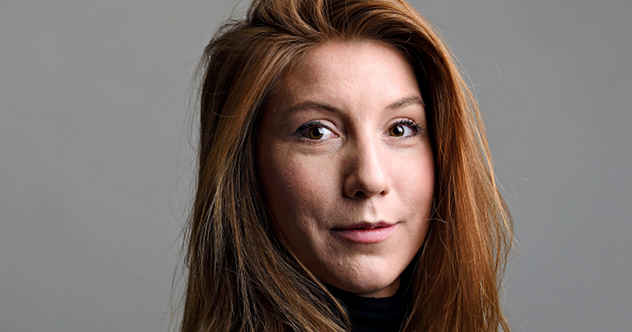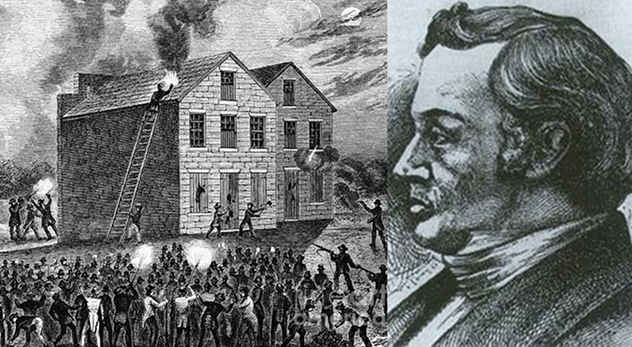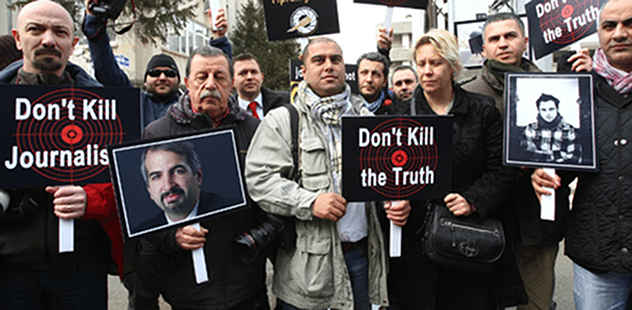 History
History  History
History  Creepy
Creepy 10 More Representations of Death from Myth, Legend, and Folktale
 Technology
Technology 10 Scientific Breakthroughs of 2025 That’ll Change Everything
 Our World
Our World 10 Ways Icelandic Culture Makes Other Countries Look Boring
 Misconceptions
Misconceptions 10 Common Misconceptions About the Victorian Era
 Mysteries
Mysteries 10 Strange Unexplained Mysteries of 2025
 Miscellaneous
Miscellaneous 10 of History’s Most Bell-Ringing Finishing Moves
 History
History 10 Great Escapes That Ended Right Back in Captivity
 Weird Stuff
Weird Stuff 10 Fascinating Things You Might Not Know About Spiders
 Food
Food 10 Everyday Foods You Didn’t Know Were Invented by the U.S. Military
 History
History 10 Most Influential Protests in Modern History
 Creepy
Creepy 10 More Representations of Death from Myth, Legend, and Folktale
 Technology
Technology 10 Scientific Breakthroughs of 2025 That’ll Change Everything
Who's Behind Listverse?

Jamie Frater
Head Editor
Jamie founded Listverse due to an insatiable desire to share fascinating, obscure, and bizarre facts. He has been a guest speaker on numerous national radio and television stations and is a five time published author.
More About Us Our World
Our World 10 Ways Icelandic Culture Makes Other Countries Look Boring
 Misconceptions
Misconceptions 10 Common Misconceptions About the Victorian Era
 Mysteries
Mysteries 10 Strange Unexplained Mysteries of 2025
 Miscellaneous
Miscellaneous 10 of History’s Most Bell-Ringing Finishing Moves
 History
History 10 Great Escapes That Ended Right Back in Captivity
 Weird Stuff
Weird Stuff 10 Fascinating Things You Might Not Know About Spiders
 Food
Food 10 Everyday Foods You Didn’t Know Were Invented by the U.S. Military
10 Journalists Who Paid The Ultimate Price
Becoming a journalist is one of the most popular childhood dreams in the world, but it often comes with a price. Those who tirelessly campaign against the powerful and corrupt sometimes find themselves facing terrifying and violent threats.
Reporters Without Borders claim that nearly half of the world lacks access to free information, and journalists across the globe still face intimidation, imprisonment, and death for daring to speak out. This is a list of ten journalists who paid the ultimate price for pursuing stories that some people did not want us to hear.
10Kim Wall

Kim Wall was a freelance journalist who had reported from countries such as Haiti, Uganda, and Sri Lanka. Originally born in Sweden, and a graduate of the London School of Economics and Columbia University, interviewing a Danish inventor probably seemed like the kind of story that simply couldn’t go wrong. But on August 10, 2017, Wall left Copenhagen harbor on Peter Madsen’s famous “homemade” submarine and was never seen alive again.
Wall was reported missing by her boyfriend when she did not return the next day. Police then sent out a rescue team to look for the submarine and found it sinking. Madsen was rescued, but Wall was nowhere to be found. It appeared that Madsen had deliberately sunk the vessel, and after initially telling authorities that he had dropped Wall off on a Copenhagen island, he changed his story, claiming that an “accident” on board had resulted in her death, and he had buried her at sea.[1]
Ten days later, Wall’s dismembered torso was found by a passing cyclist. Police told reporters that Wall’s “coagulated blood” was also found on the submarine, and her limbs had been deliberately cut from her body. There were marks on her torso suggesting someone had tried to “press air” out of it to prevent it from floating, and a piece of metal had been attached, presumably to help it sink.
Two months after her disappearance, divers found plastic bags containing Wall’s severed head, items of her clothing, and other body parts. Some of Wall’s body is still missing, and it is not yet known how she died, or why her body was dismembered.
9Natalia Estemirova

Natalia Estermirova was an esteemed Chechen journalist and tireless critic of Vladimir Putin. She had won international awards for her work as both a writer and human rights activist. Just hours before Estermirova was killed, she had attended a press conference calling for Putin to be prosecuted in an international court for crimes in her native Chechnya. She was also an outspoken opponent of the Kremlin-backed Chechen President, Ramzan Kadyrov.
Before her death, Estemirova had published a report accusing members of the Kadyrov administration of carrying out revenge killings, and she had also begun to express to her friends that she feared for her safety, and the safety of her fifteen-year-old daughter. Her friends and daughter claimed she was receiving threats from senior officials. Then, on a July morning in 2009, Estemirova set off for her usual 20-minute journey to work. She made it just 100 meters from her 10th floor flat in Grozny before four gunmen grabbed her, and threw her into white car. The kidnapping was witnessed by a passer-by. The car drove to the Russian republic of Ingushetia, where Estemirova, with her hands tied, was shot five times in the head and chest. When her body was found, she still had her money, passport, and ID.
The official investigation concluded that Estemirova was killed by an armed militant group known as Alkhazur Bashaev, but few accept that story.[2]
8Elijah Parish Lovejoy

Elijah Parish Lovejoy was an American minister, journalist, and abolitionist. Born in 1802, Lovejoy attended Colby College in his home state of Maine and graduated as a valedictorian and class poet. Lovejoy later moved to Missouri, where he began writing for a religious newspaper: the St. Louis Observer.[3]
There, Lovejoy began using his editorial to condemn slavery and soon began receiving threats against himself, and his family. When he condemned the lynching of a free African-American man without trial, a judge presiding over the case blamed Lovejoy for the murder, accusing him of stirring up the mob with his anti-slavery writings. A mob then broke into Lovejoy’s office and destroyed his printing press, prompting him to make the decision to move to Illinois, a formally anti-slavery state.
However, the people of Illinois were also hostile to Lovejoy’s abolitionist views. The first two printing presses he purchased were destroyed, despite attempts to deliver them in the middle of the night and hide them in a warehouse. Lovejoy and his colleagues had to constantly guard the warehouse where they stored their resources. When a local mob got word that another printing press was due to arrive on November 7, 1837, they stormed the building and set it on fire. As Lovejoy tried to extinguish the blaze, he was shot by an unknown assailant.
7Bernard Darke

Bernard Darke was a British-born Jesuit priest, and a part-time photographer for The Catholic Standard, a weekly, religious Guyanese newspaper. The newspaper was run by Andrew Morrison, a Georgetown native and outspoken opponent of Forbes Burnham, a socialist leader who acted as Prime Minister, and then President of Guayana from 1964 to 1985.
On July 14, 1979, there was a large demonstration in Georgetown against the government of Forbes Burnham. Darke was there taking pictures when a pro-government mob began to attack the protestors. Three of the assailants then turned on Darke, beating him with staffs. He was then chased to a street corner, where he was stabbed in the back with a bayonet. He suffered significant damage to one of his lungs and later died in hospital.[4]
Five people were arrested, and one charged with the murder of Bernard Darke. All five men were members of the “House of Israel,” a cult led by US born David Hill. The cult has no ties to Israel, nor Judaism, and just seven years later, Hill would also be charged in the murder of one of his followers.
6Habiba Ahmed Abd Elaziz

Habiba Ahmed Abd Elaziz was an Egyptian journalist and activist and was among the many who were killed during the Raab massacre of 2013. She wrote for Xpress News in Dubai, but was reportedly on annual leave at the time and attending the protests as a civilian.
On August 14, 2013, Habiba was attending a protest in Cairo in support of the deposed President, Mohammed Morsi. Her father had been a media advisor to Morsi. The demonstrations soon turned violent when security forces stormed two protest camps, and at least 412 people were killed. Habiba was staying in a nearby mosque that had been turned into a makeshift hospital. Her last texts, to her mother, stated that the crowd was on “high alert” and that she was heading on to a platform. Around midday, Habiba’s mother tried calling. A stranger picked up and told her that her daughter was dead.[5] She had been shot in the head.
In 2014, Habiba’s brother, Mosaab, was arrested in Abu Dhabi and accused of having ties to the Muslim Brotherhood. He was deported, and sentenced to three years in prison with no right to appeal the decision. He was kept in solitary confinement and was not allowed to contact his family until 2015. He says he was tortured, and forced to sign a confession.
5Fritz Gerlich

Fritz Gerlich was a right-wing journalist and well-known political analyst in 1930s Germany. He studied history at the University of Munich and was an outspoken opponent of both Communism and Nazism. He condemned anti-Semitism and even met with Adolf Hitler three times in 1923.
Gerlich was appalled by the Beer Hall Putsch, and he left his newspaper in 1931 when the editor began to fund Hitler’s campaign. He began publishing his own weekly newsletter, and predicted that Hitler’s leadership would lead to “enmity with neighboring countries, internal totalitarianism, civil war, international war, lies, hatred, fratricide and infinite trouble.” After the death of Hitler’s niece, officially ruled a suicide, Gerlich published a report stating he had evidence Hitler had ordered her killing. He then began to mock Hitler by using “racial science” to claim that he was not Aryan, but Mongolian.[6] By 1932, Gerlich’s newspaper had a circulation of over 100,000 readers.
Just one year later, Hitler would be in power, and Gerlich was one of his first victims. Just one day after seizing control, the SA (a paramilitary predecessor to the SS) stormed Gerlich’s offices and arrested him. The editorial staff was attacked, machines and desks destroyed, and Gerlich was tortured in prison. On June 30, 1934, now known as the Night of the Long Knives, Gerlich was transferred to the Dachau Concentration Camp and immediately assassinated. Authorities notified his wife of his death by sending her his blood-stained glasses.
4Anabel Flores Salazar

Anabel Flores Salazar was Mexican journalist from Veracruz state. She reported for El Sol de Orizaba on crime, corruption, and police activity. Two newspapers she had previously worked for had been attacked by gunmen in 2011. She was currently reporting on the case of a store owner who had been shot dead, and she was investigating the mysterious deaths of several teenage girls in her neighborhood.[7]
At 2:00 a.m. on February 8, 2016, a group of armed men entered Flores Salazar’s home. They were reportedly wearing military uniforms and claimed to have a warrant for her arrest. Her aunt, who was also in the house at the time, pleaded with them, telling the assailants that she had recently had a baby. Flores Salazar was taken into one of three grey trucks that were parked outside, and she was never seen alive again. A day later, her body was found on a highway in a neighboring state. She was half-naked, her hands and feet had been bound, and there was a plastic bag covering her head. She had died of suffocation.
Flores Salazar left behind two children; a baby and a four-year-old. She was the third journalist to be killed in Mexico in 2016.
3Naseem Intriri

Naseem Intiri was a British freelance journalist who was covering the war in Syria when she was killed. Intiri was staying with a group of Syrian activists and other journalists in Darkoush, near the Turkish-Syrian border. They were reportedly filming a documentary about Syrian refugees. The Syrian government has banned most international journalists from covering the war, and many have to smuggle themselves in, making it an incredibly risky job.[8]
A witness reported that Syrian soldiers and a plain-clothed militia known as the “Shabiha” began shooting at the house where the journalists were staying on a Monday morning in March 2012. He said that the journalists were initially able to flee, but returned to retrieve their equipment when the shooting appeared to stop. One person was shot in the head, and another in the chest. The witness claimed that the military took away their bodies. Another journalist was shot in the shoulder and was able to flee and received treatment in Antakya, Turkey.
That same week, a Kurdish photographer was kidnapped and murdered by unknown assailants. His body reportedly showed clear signs of torture. Syria is ranked as one of the most dangerous countries in the world for journalists.
2Marisol Macías Castañeda

Marisol Macías Castañeda was a Mexican journalist and the editor-in-chief of Primera Hora, a local newspaper in Nuevo Laredo. She had previously worked for a newspaper, El Mañana, that was attacked once in 2004, and again in 2006. Marisol, or María, also helped moderate an online site; Nuevo Laredo Live, where locals could anonymously post about local gangs. Her pseudonym was “The Girl from Laredo.” People posted everything from the addresses of local gang safe houses, where gang members were living, and even where they were selling drugs. Many suspect the website of belonging to the federal government.[9]
In September 2011 Castañeda’s body was found decapitated on a local street. Her head was found on a large stone piling nearby. Next to her remains was a handwritten note that read, “Nuevo Laredo en Vivo and social networking sites, I’m The Laredo Girl, and I’m here because of my reports, and yours, for those who don’t want to believe, this happened to me because of my actions, for believing in the army and the navy. Thank you for your attention, respectfully, Laredo Girl . . . ZZZZ.”
Earlier that same month, a couple were found hanging from an overpass in Nuevo Lareda with similar notes claiming they were killed in retaliation for posting on social media. The woman had been disemboweled. Two months after Castañeda’s death, the body of a young man was found in the exact same spot as she was, also having been decapitated, with another note warning against posting on the website, Nuevo Laredo Live.
1Serena Shim

Serena Shim was a US journalist who was reporting in Turkey at the time of her death. She was working for Press TV. She had broadcasted from places such as Iraq, Syria, and Ukraine and was reporting on the presence of IS and Al-Qaeda militants on the Turkish-Syrian border. Her work is currently on display at the Arab American National Museum in Dearborn, Michigan.[10]
After returning to Turkey in October 2014, she discovered that the Turkish National Intelligence Organisation was actively seeking information on her whereabouts. Reportedly, she had been labeled a spy. Shim stated this on a live broadcast for Press TV. Just one day later, the rental car she was driving was involved in a fatal car crash. She reportedly died of heart failure in the hospital, but there has never been an official investigation into her death.
Turkey has been referred to as the “world’s largest prison for journalists” by Reporters Without Borders, and Shim reportedly feared that she would soon be arrested. Many, including colleagues and family, believe that she was assassinated by the government. But without any real evidence, it is impossible to know what really happened to Serena Shim.
Kitty is an aspiring author who likes to write about books, language, and anything else in between. You can read more of her writing at www.thelittlestlibrary.co.uk.
Read more about journalism and free speech on Top 10 Impressive Times The Press Spoke Truth To Power and Top 10 Terrifying Assaults On Free Speech Happening Right Now.

